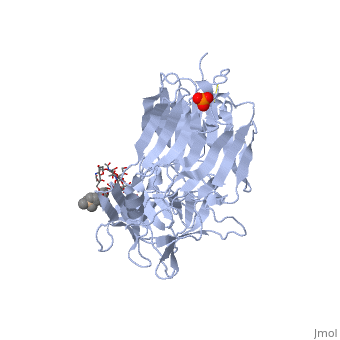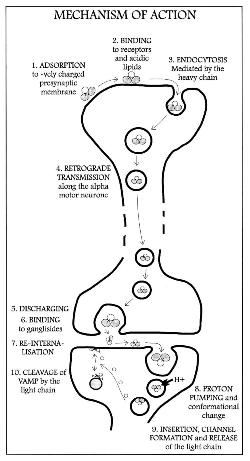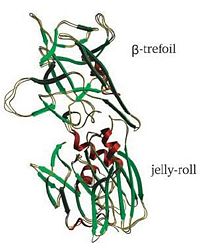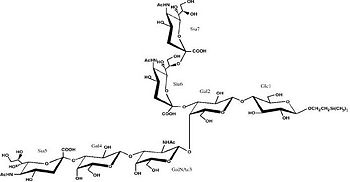Tetanus toxin
From Proteopedia
(Difference between revisions)
| (One intermediate revision not shown.) | |||
| Line 21: | Line 21: | ||
== ''Clostidium tetani'' == | == ''Clostidium tetani'' == | ||
| - | The Gram positive bacilli ''Clostridium tetani'' is the bacteria responsible for the disease state of tetanus. The presence of the bacteria does not cause the disease but instead the toxins it produces cause the disease state. ''C. tetani'' produces two toxins; '''tetanospasmin''' and '''tetanolysin''' or '''tentoxylysin'''. Tetanolysin is a cytolysin that increases the permeability of cellular membranes through cell lysis.<ref> PMID: 2404569</ref> Tetanospasmin is the cause of tetanus and is sometimes referred to as tetanus neurotoxin (TeNT), as it acts on the central nervous system. Tetanospasmin makes its way to the central nervous system via retrograde axonal flow beginning with α- motor neurons found in muscle and ending by binding to gangliosides found in the central nervous system | + | The Gram positive bacilli ''Clostridium tetani'' is the bacteria responsible for the disease state of tetanus. The presence of the bacteria does not cause the disease but instead the toxins it produces cause the disease state. ''C. tetani'' produces two toxins; '''tetanospasmin''' and '''tetanolysin''' or '''tentoxylysin'''. Tetanolysin is a cytolysin that increases the permeability of cellular membranes through cell lysis.<ref> PMID: 2404569</ref> Tetanospasmin is the cause of tetanus and is sometimes referred to as tetanus neurotoxin (TeNT), as it acts on the central nervous system. Tetanospasmin makes its way to the central nervous system via retrograde axonal flow beginning with α- motor neurons found in muscle and ending by binding to gangliosides found in the central nervous system, i.e. CNS..<ref> Bizzini B. Tetanus Toxin. Microbiological Reviews.1979 June;43(2):224-236.[http://www.ncbi.nlm.nih.gov/pmc/articles/PMC281472/pdf/microrev00006-0112.pdf?tool=pmcentrez]</ref> |
[[Image:Mechanism_of_action_of_tetanospasmin.jpg|thumb|350px|left|Mechanism of Action for Tetanospasmin.<ref> Mechanism of Action of Tetanospasmin (Dr. Arnab K Rana) [image on the internet]. 2005[updated 2005 Dec 26; cited 2011 Apr 20]. Available from: http://en.wikipedia.org/wiki/File:Mechanism_of_action_of_tetanospasmin.gif</ref>]] | [[Image:Mechanism_of_action_of_tetanospasmin.jpg|thumb|350px|left|Mechanism of Action for Tetanospasmin.<ref> Mechanism of Action of Tetanospasmin (Dr. Arnab K Rana) [image on the internet]. 2005[updated 2005 Dec 26; cited 2011 Apr 20]. Available from: http://en.wikipedia.org/wiki/File:Mechanism_of_action_of_tetanospasmin.gif</ref>]] | ||
| Line 88: | Line 88: | ||
*Tetanus toxin light chain | *Tetanus toxin light chain | ||
| - | **[[1yvg]] - CtTeNT Lc – ''Clostridium tetani''<br /> | + | **[[1yvg]] - CtTeNT Lc 1-427 – ''Clostridium tetani''<br /> |
| - | **[[1z7h]], [[4j1l]] - CtTeNT Lc (mutant) | + | **[[1z7h]], [[4j1l]], [[7by5]] - CtTeNT Lc (mutant) |
| + | **[[7ce2]], [[7oh0]], [[7oh1]] - CtTeNT Lc 11-451 + antibody<br /> | ||
| - | *Tetanus toxin heavy chain | + | *Tetanus toxin heavy chain; Domains – translocation 459-865; receptor binding (RBD) 865-1315 |
| - | **[[1a8d]], [[1af9]] - CtTeNT Hc (mutant)<br /> | + | **[[5n0b]], [[5n0c]] - CtTeNT (mutant)<br /> |
| + | **[[1a8d]], [[1af9]] - CtTeNT Hc RBD (mutant)<br /> | ||
**[[1dfq]], [[1yyn]] – CtTeNT Hc + sialic acid <br /> | **[[1dfq]], [[1yyn]] – CtTeNT Hc + sialic acid <br /> | ||
**[[1diw]] - CtTeNT Hc + galactose<br /> | **[[1diw]] - CtTeNT Hc + galactose<br /> | ||
**[[1dll]] - CtTeNT Hc + lactose<br /> | **[[1dll]] - CtTeNT Hc + lactose<br /> | ||
**[[1d0h]] - CtTeNT Hc (mutant) + N-acetyl-galactosamine<br /> | **[[1d0h]] - CtTeNT Hc (mutant) + N-acetyl-galactosamine<br /> | ||
| - | **[[1fv2]], [[1fv3]] - CtTeNT Hc + ganglioside analog<br /> | + | **[[1fv2]], [[1fv3]] - CtTeNT Hc RBD + ganglioside analog<br /> |
| - | **[[1yxw]] - CtTeNT Hc + tripeptide<br /> | + | **[[1yxw]] - CtTeNT Hc RBD + tripeptide<br /> |
| - | **[[3hmy]] - CtTeNT Hc + GT2<br /> | + | **[[3hmy]] - CtTeNT Hc RBD + GT2<br /> |
| - | **[[3hn1]] - CtTeNT Hc + GT2 + lactose | + | **[[3hn1]] - CtTeNT Hc RBD + GT2 + lactose |
| + | **[[7bxx]] - CtTeNT translocation domain (mutant)<br /> | ||
| + | **[[7by4]] - CtTeNT RBD <br /> | ||
| - | *Tetanus toxin light+heavy chain | ||
| - | |||
| - | **[[5n0b]] - CtTeNT <br /> | ||
| - | **[[5n0c]] - CtTeNT (mutant)<br /> | ||
}} | }} | ||
| - | |||
| - | |||
==References== | ==References== | ||
<references /> | <references /> | ||
[[Category:Topic Page]] | [[Category:Topic Page]] | ||
Current revision
| |||||||||||
3D structures of tetanus toxin
Updated on 18-August-2024
References
- ↑ Hatheway CL. Toxigenic clostridia. Clin Microbiol Rev. 1990 Jan;3(1):66-98. PMID:2404569
- ↑ Bizzini B. Tetanus Toxin. Microbiological Reviews.1979 June;43(2):224-236.[1]
- ↑ Mechanism of Action of Tetanospasmin (Dr. Arnab K Rana) [image on the internet]. 2005[updated 2005 Dec 26; cited 2011 Apr 20]. Available from: http://en.wikipedia.org/wiki/File:Mechanism_of_action_of_tetanospasmin.gif
- ↑ Lalli G, Schiavo G. Analysis of retrograde transport in motor neurons reveals common endocytic carriers for tetanus toxin and neurotrophin receptor p75NTR. J Cell Biol. 2002 Jan 21;156(2):233-9. Epub 2002 Jan 21. PMID:11807088 doi:10.1083/jcb.200106142
- ↑ Mocchetti I. Exogenous gangliosides, neuronal plasticity and repair, and the neurotrophins. Cell Mol Life Sci. 2005 Oct;62(19-20):2283-94. PMID:16158191 doi:10.1007/s00018-005-5188-y
- ↑ 6.0 6.1 Chen C, Fu Z, Kim JJ, Barbieri JT, Baldwin MR. Gangliosides as high affinity receptors for tetanus neurotoxin. J Biol Chem. 2009 Sep 25;284(39):26569-77. Epub 2009 Jul 14. PMID:19602728 doi:10.1074/jbc.M109.027391
- ↑ 7.0 7.1 7.2 7.3 7.4 7.5 7.6 7.7 7.8 Fotinou C, Emsley P, Black I, Ando H, Ishida H, Kiso M, Sinha KA, Fairweather NF, Isaacs NW. The crystal structure of tetanus toxin Hc fragment complexed with a synthetic GT1b analogue suggests cross-linking between ganglioside receptors and the toxin. J Biol Chem. 2001 Aug 24;276(34):32274-81. Epub 2001 Jun 19. PMID:11418600 doi:10.1074/jbc.M103285200





